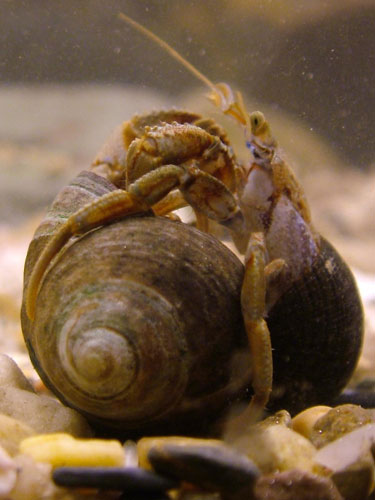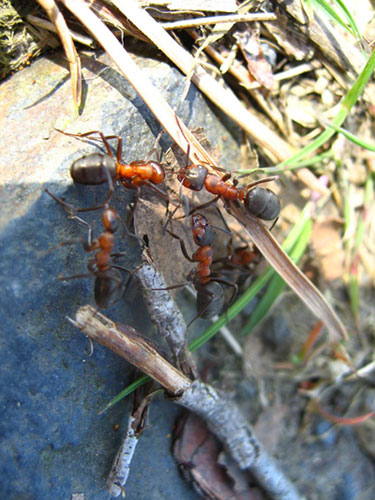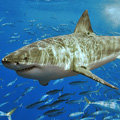« Prev Next »

When male fig wasps, Idarnes spp., hatch inside the fig they attempt to decapitate their brothers that hatch in the same fig, attacking them with large and powerful mandibles (Hamilton 1967). Similarly, male elephant seals (Mirounga angustirostris) may kill rivals during fights over access to females (Hayley 1994) and male fallow deer (Dama dama) employ violent head-on "jump clashes" during the rut at the start of the breeding season (Jennings et al. 2005). In these three examples, aggressive behavior is being used by each rival in order to maximize its chances of success in a conflict over who gets to mate with the available females.

How can non-injurious aggressive behaviors — especially displays — induce one opponent to give up and relinquish a valuable resource? One argument is that "dangerous fighting would harm the species" (e.g., Huxley 1966) but if aggressive behavior is a result of natural selection, avoiding dangerous fighting "for the good of the species" is unlikely. Rather, we should expect to see individuals act to maximize their own fitness, regardless of the effect on the species. In order to understand how non-injurious fighting could evolve through natural selection, an approach called game theory, borrowed from the field of economics, has been used to construct models of the evolutionary processes that could result in aggressive behavior. Contests are regarded as "games" played out between two or more alternative strategies. The aim of the model is to determine which of the alternatives should be favored by natural selection. If one strategy, once adopted by most of the population, is immune to invasion by any of the alternatives in the game, it is called the evolutionarily stable strategy (ESS). The first game theory model of fighting is known as the Hawk-Dove game (although in its first iteration it was called the Hawk-Mouse game) (Maynard Smith & Parker 1976). This model pits a Hawk strategy (always try to injure your opponent and only withdraw from the contest if an injury is received) against a Dove strategy (always use a non-injurious display if the rival is another Dove and always withdraw if the rival is a Hawk). In order to find the ESS, the first stage is to specify the average payoffs (that is, the benefit in fitness, denoted as E) for individuals playing Hawk or Dove against opponents playing Hawk or Dove. This is best represented by a payoff matrix (Table 1).

In this very simple model, an individual playing the Hawk strategy against another Hawk is assumed to have a 50% chance of winning and a 50% chance of losing. The average payoff of playing Hawk against another Hawk therefore includes half the value of the resource, from the 50% of contests that they are expected to win. But since they only withdraw when injured we also have to add half of the cost of receiving an injury from the 50% of contests that they will lose. Clearly, an injury will have negative fitness consequences in contrast to the positive fitness consequences gained from winning the resource. The average payoff is therefore ½ of the positive value of the resource (V) plus ½ of the negative value of picking up an injury (C), which can also be written as: E = ½ (V - C). When a Hawk fights a Dove, however, the Hawk will always win with no risk of picking up an injury, so the average payoff to Hawks fighting Doves is V. Conversely, the average payoff to a Dove fighting a Hawk is 0 (zero), because the Dove will always lose but avoid an injury by just running away. For a Dove fighting another Dove, we again assume that there is a 50% chance of winning, but in this case there is no chance of receiving an injury as Doves never try to injure their opponent. The average payoff for playing Dove against another Dove is therefore ½V. Now that we have built the model, we can plug in some values for C and V, or "parameterize the model"). The next step is to calculate the payoffs in each cell of the matrix, given the values of C and V that we have chosen to use. Let’s say that V = 50 and C = -25 (so in magnitude C < V). For Hawk against Hawk E = +12.5, for Dove against Hawk E = 0, for Hawk against Dove E = 50, and for Dove against Dove E = 25. The last step is to find the ESS by "running the model," which involves doing a kind of evolutionary thought experiment:
In an ancestral population where most individuals played Dove, E = +25 but if a mutation for Hawk arose the average payoff for individuals bearing this mutation would be +50. Since this is better than +25, the mutation would quickly spread through the population meaning that Dove is not an ESS. On the other hand, a Dove mutation could not invade a population of Hawks because the average payoff to Hawks fighting Hawks is +12.5, which is better than the payoff of 0 received by a Dove that fights a Hawk. In this run of the model, where the value of the resource outweighs the cost of an injury, we find that natural selection is not expected to favor non-dangerous Dovelike behavior over dangerous Hawk-like behavior. In fact, the examples of injurious or even fatal fighting described above all occur when the benefits of winning the resource are extremely high in comparison to the cost of receiving an injury. In elephant seals, receiving an injury or being killed is obviously not good, but challenging the dominant male for a chance to mate is the only way to achieve any reproductive success. In fitness terms, failing to reproduce is worse than picking up an injury and just as bad as being killed.
However, in a contest over a resource other than a direct chance of securing limited mating opportunities, such as a fight over food, shelter, or territory, it is hard to see how the cost of picking up a serious injury would be as bad as losing the resource. If we re-parameterize the model such that C > V (say V still = 50, but C is now = -100) the results are different. By plugging these new values into the matrix, we now find that while Hawk could still invade an ancestral population of Doves, Dove can also invade an ancestral population of Hawks! We can try running the model with different ratios between C and V but as long as C > V the overall result is always the same, with neither strategy being immune to invasion by the other. This is called a "mixed ESS." This model predicts that evolution will proceed to an equilibrium where there is a mixture of Dovelike and Hawklike behavior in the population. This could involve some individuals playing Hawk all the time and others playing Dove all the time; or it could mean that all individuals use a mixture of Hawk and Dove behavior. Thus, in situations when C > V, a proportion of contests are predicted by the Hawk-Dove game to be settled through non-injurious fighting.

As with all theoretical models in biology, models of aggression are not intended as exact representations of the real world. Rather, the aim is to see whether an idea — "settling contests through signals can evolve due to the benefits to individuals, not the group" or "the loser gives up when it crosses an individual threshold of cost" — is a reasonable one that could at least work in a very simplified version of the real world. In the field of animal aggression and territoriality, as in other examples of animal behavior, the reality is likely to be far more complex than the simplified situations that can be modeled in a useful way. In killifish, for example, fighting males appear to switch between mutual and self assessment in different phases of the fight (Hsu et al. 2008) and in hermit crabs one of the individuals seems to assess its opponent’s RHP, while the other seems to assess only its own condition (Briffa & Elwood 2002). Nevertheless, aggression occurs in almost all animal taxa and takes a wide variety of forms encompassing aerial displays in butterflies (Kemp 2002), battles between rival armies in ants (Batchelor & Briffa 2010) (Figure 2) through to biting and gouging in elephant seals (Hayley 1994). The fact that many empirical studies of real animal contests are informed by a well-developed body of theory helps us to understand how natural selection can lead to the evolution of aggression in its varied forms.
References and Recommended Reading
Briffa, M. & Elwood, R. W. Power of shell-rapping signals influences physiological costs and subsequent decisions during hermit crab fights. Proceedings of the Royal Society of London Series B-Biological Sciences 269, 2331-2336 (2002).
Briffa, M. & Sneddon, L. U. Contest behavior. In Evolutionary Behavioral Ecology. eds. Westneat, D. F. & Fox, C. W. New York: Oxford University Press, 2010.
Batchelor, T. P. & Briffa, M. Influences on resource-holding potential during dangerous group contests between wood ants. Animal Behaviour (in press, 2010).
Clutton-Brock, T. H. & Albon, S. D. The roaring of red deer and the evolution of honest advertisement. Behaviour 69,145-170 (1979).
Hamilton, W. D. Extraordinary sex ratios. Science 156, 477-488 (1967).
Haley, M. P. Resource-holding power asymmetries, the prior residence effect, and reproductive payoffs in male northern elephant seal fights. Behavioral Ecology and Sociobiology 34, 427-434 (1994).
Hsu, Y., Lee, S. P. et al. Switching assessment strategy during a contest: fighting in killifish Kryptolebias marmoratus. Animal Behaviour 75,1641-1649 (2008).
Huxley, J. S. A discussion of ritualisation of behaviour in animals and man: introduction. Philosophical Transactions of the Royal Society B 251, 247-271 (1966).
Jennings, D. J., Gammell, M. P. et al. An investigation of assessment games during fallow deer fights. Ethology 111, 511-525 (2005).
Kemp, D. J. Butterfly contests and flight physiology: Why do older males fight harder? Behavioral Ecology 13, 456-461 (2002).
Maynard Smith, J. & Parker, G. The logic of asymmetric contests. Animal Behaviour 24, 159-175 (1976).
Morrell, L. J., Backwell, P. R. Y. et al. Fighting in fiddler crabs Uca mjoebergi: what determines duration? Animal Behaviour 70, 653-662 (2005).
Mowles, S. L., Cotton, P. A. et al. Whole-organism performance capacity predicts resource holding potential in the hermit crab Pagurus bernhardus. Animal Behaviour (in press, 2010).
Payne, R. J. H. & Pagel, M., Why do animals repeat displays? Animal Behaviour 54, 109-119 (1997).






























